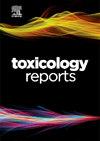Prolonged sedation and unconsciousness after intoxication with the novel semisynthetic cannabinoid hexahydrocannabioctyl (HHC-C8): Two case descriptions
Q1 Environmental Science
引用次数: 0
Abstract
Semisynthetic cannabinoids (SSCs) are compounds closely related to the major phytocannabinoids. SSCs have recently appeared as legal alternatives to Δ9-tetrahydrocannabinol (Δ9-THC), the primary psychoactive compound in the Cannabis plant. Δ9-THC has been consumed by humans for millennia and has low acute toxicity, but recent evidence indicates elevated toxicity from exposure to some SSCs. The present study describes two case reports with confirmed intoxication with a novel SSC, hexahydrocannabioctyl (HHC-C8). In the first case, a young male was found deeply unconscious and hospitalized. The clinical picture was mostly neurological with recurring seizures and coma. The patient was comatose for two days with a slow gradual improvement over the following two weeks. An HHC-C8 blood concentration of 72 ng/mL was determined in a sample taken at time of admission and the compound was also confirmed at a concentration of 6 % in a cannabis product of the same type and purchased at the same store. In the second case, a female was hospitalized after having slept for 14 hours and found in a minimally responsive state. The patient suffered pronounced somnolence and sedation for 3 days after which she gradually recovered. In a blood sample taken 40 hours after ingestion, HHC-C8 was detected at trace amounts along with two putative metabolites. The ingested product, which the patient had purchased at a web shop, was found to contain 7 % HHC-C8. The two cases demonstrate the toxic potential of widely available and often mislabeled cannabis products, the intake of which can lead to intoxications requiring extensive medical treatment.
新型半合成大麻素六氢大麻辛基(HHC-C8)中毒后的长时间镇静和无意识:两个病例描述。
半合成大麻素(ssc)是与主要植物大麻素密切相关的化合物。ssc最近作为大麻植物中主要的精神活性化合物Δ9-tetrahydrocannabinol (Δ9-THC)的合法替代品出现。Δ9-THC已经被人类食用了几千年,具有较低的急性毒性,但最近的证据表明,接触某些ssc会增加毒性。本研究描述了两例病例报告,证实中毒与一种新的SSC,六氢大麻辛基(HHC-C8)。在第一起案件中,一名年轻男性被发现深度昏迷并住院治疗。临床表现以神经学为主,伴有反复发作和昏迷。患者昏迷两天,随后两周逐渐缓慢好转。在入院时采集的样本中测定了HHC-C8血液浓度为72 ng/mL,并确认在同一商店购买的同一类型大麻产品中该化合物的浓度为6 %。在第二个病例中,一名女性在睡了14 小时后住院,发现处于最低反应状态。患者明显嗜睡,镇静3天后逐渐恢复。在摄入40 小时后采集的血液样本中,检测到微量的HHC-C8以及两种推定的代谢物。该患者从网上商店购买的摄入产品被发现含有7 % HHC-C8。这两个案例表明,广泛供应且往往贴错标签的大麻产品具有潜在毒性,摄入这种产品可能导致中毒,需要广泛的医疗。
本文章由计算机程序翻译,如有差异,请以英文原文为准。
求助全文
约1分钟内获得全文
求助全文
来源期刊

Toxicology Reports
Environmental Science-Health, Toxicology and Mutagenesis
CiteScore
7.60
自引率
0.00%
发文量
228
审稿时长
11 weeks
 求助内容:
求助内容: 应助结果提醒方式:
应助结果提醒方式:


